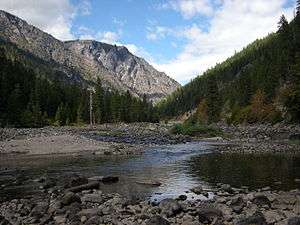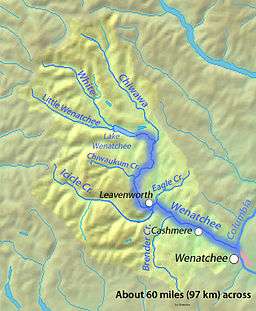Wenatchee River
| Wenatchee River | |
 The Wenatchee River west of Leavenworth | |
| Country | United States |
|---|---|
| State | Washington |
| County | Chelan |
| Source | Lake Wenatchee |
| - coordinates | 47°48′28″N 120°43′39″W / 47.80778°N 120.72750°W [1] |
| Mouth | Columbia River |
| - location | Wenatchee |
| - coordinates | 47°27′19″N 120°19′28″W / 47.45528°N 120.32444°WCoordinates: 47°27′19″N 120°19′28″W / 47.45528°N 120.32444°W [1] |
| Length | 53 mi (85 km) |
| Basin | 1,333 sq mi (3,452 km2) [2] |
| Discharge | for river mile 7 at Monitor |
| - average | 3,231 cu ft/s (91 m3/s) [3] |
| - max | 45,200 cu ft/s (1,280 m3/s) |
| - min | 221 cu ft/s (6 m3/s) |
 Map of the Wenatchee River | |
|
Mouth of the Wenatchee River in Washington | |
| Wikimedia Commons: Wenatchee River | |
The Wenatchee River is a river in the U.S. state of Washington, originating at Lake Wenatchee and flowing southeast for 53 miles (85 km), emptying into the Columbia River immediately north of Wenatchee, Washington. On its way it passes the towns of Plain, Leavenworth, Peshastin, Dryden, Cashmere, Monitor, and Wenatchee, all within Chelan County.
Tributaries include the Chiwawa River, Nason Creek, Peshastin Creek, and Icicle Creek. Its drainage basin is 1,333 square miles (3,450 km2) in area.[2]
History
Historically the dividing line between Okanogan County and Kittitas County, the river has been in the center of Chelan County since the county's formation around 1899.
Water from the Wenatchee River and its tributaries has been diverted for irrigation since 1891, mainly for orchards. There are two small dams on the Wenatchee River, the Tumwater Canyon Dam, which sits just west of the community of Leavenworth, and the Dryden dam, a low-head dam situated just outside the town of Dryden. The Tumwater Canyon dam originally provided power to the original 2-mile (3.2 km)-long railroad tunnel used near Stevens Pass to get trains across the Cascade Mountains, it was later (starting in 1928) used to power the railroad's electrification from Wenatchee to Skykomish.
Pollution
Toxic chemicals banned decades ago in Washington continue to linger in the environment and concentrate in the food chain, threatening people and the environment, according to three recent studies by the Washington state Department of Ecology. In 2007, the Washington Department of Health advised the public to not eat mountain whitefish from the Wenatchee River from Leavenworth downstream to where the river joins the Columbia, due to unhealthy levels of PCBs.[4]
See also
References
- 1 2 U.S. Geological Survey Geographic Names Information System: Wenatchee River
- 1 2 "Wenatchee Subbasin Plan". Northwest Power and Conservation Council. Retrieved 30 July 2009.
- ↑ "Water Resources Data-Washington Water Year 2005; Entiat, Wenatchee, and Sand Hollow River Basins and the Columbia River from Wells Dam to Rock Island Dam" (PDF). USGS. Retrieved 31 July 2009.
- ↑ http://www.ens-newswire.com/ens/jun2007/2007-06-25-01.asp
External links
 Media related to Wenatchee River at Wikimedia Commons
Media related to Wenatchee River at Wikimedia Commons